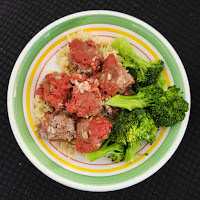Last week, I received an email from Crosby's introducing their new product: maple molasses. Curious, I followed the link to their website. Sure enough, they have blended maple syrup and (presumably fancy) molasses into a new offering. While I think it is meant to be a pancake syrup, they are releasing new recipes featuring it as an ingredient. First there were muffins, then there were cookies. Both seemed appealing.
Unfortunately, Crosby's Maple + Molasses doesn't appear to be available in local stores yet and I wasn't about to pay the exorbitant shipping fee ($24.01!) for the $8.99 bottle, so I quickly returned to my previously scheduled programming.
But the "Wholesome Maple + Molasses Peanut Butter Muffins" had infiltrated my brain and I couldn't stop thinking about them (peanut butter fiend that I am). And so I returned to their website to read more about the product. The label states that the product is 70% maple syrup, which was enough information for me to mix my own reasonable facsimile. I was in business! (Metaphorically, of course. I am not going to be producing a Maple + Molasses knock off for sale.)
The recipe for the muffins was of interest for the inclusion of both rolled oats and peanut butter. In my head, that meant fibre and flavour. They were quick to mix up, taking less than 10 minutes, and they baked in only 18 minutes. Voila!
Now, I'm not sure how wholesome these muffins actually are. They have three different types of sugar (brown sugar, maple syrup, and molasses) and they contain peanut butter, which is typically high in fat. According to the online calculator I used, they contain 180 calories, 4g fat, 2g fibre, and 5g protein. Of course they do wonderful things for one's mental health, so everything in moderation (including moderation) and all that jazz.






